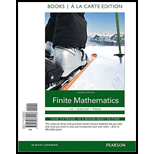
Concept explainers
Landlines The percent of U.S. households with telephone landlines has decreased at a roughly linear rate, as shown by Che following table. Source: Centers for Disease Control and Prevention.
| Year | Percent of Households |
| 2005 | 89.7 |
| 2006 | 84.1 |
| 2007 | 81.9 |
| 2008 | 77.9 |
| 2009 | 73.5 |
| 2010 | 68.2 |
| 2011 | 63.8 |
| 2012 | 59.6 |
(a) Find the equation of the least squares line, letting x equal the number of years since 2000.
(b) Based on your answer to part (a), at approximately what rate is the percent of households with landlines decreasing per year?
(c) Use your result from part (a) to predict the percent of households with landlines in the year 2015.
(d) If this trend continues linearly, in what year will the percent of households with landlines first dip below 40%?
(e) Find and interpret the
Want to see the full answer?
Check out a sample textbook solution
Chapter 1 Solutions
Finite Mathematics, Books a la Carte Plus MyLab Math Access Card Package (11th Edition)
- x-4 Let f(x)=5x-1, h(x) = Find (fo h)(0). 3 (fo h)(0) = (Type an integer or a fraction.)arrow_forwardFill in the blanks to write the calculus problem that would result in the following integral (do not evaluate the interval). Draw a graph representing the problem. π/2 So/² 2xcosx dx Find the volume of the solid obtained when the region under the curve 38,189 on the interval is rotated about the axis.arrow_forwardLet f(x) = -5x-1, g(x) = x² + 5, h(x) = · x+4 3 Find (hog of)(1). (hogof)(1)= (Simplify your answer. Type an integer or a decimal.)arrow_forward
- For the given function, find (a) the equation of the secant line through the points where x has the given values and (b) the equation of the tangent line when x has the first value. y= f(x) = x²+x; x=-1,x=2 a. Which of the following formulas can be used to find the slope of the secant line? ○ A. 2-(-1) f(2) f(-1) 2+(-1) C. 1(2)+(-1) The equation of the secant line is 1(2)+(-1) О в. 2+(-1) f(2)-(-1) D. 2-(-1)arrow_forwardplease do not use chat gptarrow_forwardUse technology to find f'(4), f'(16), f'(-5) for the given function when the derivative exists. f(x) = -2x² + +10xarrow_forward
- 42. Consider the following joint probability table. B₁ B2 B3 B4 A 0.09 0.22 0.15 0.20 A 0.03 0.10 0.09 0.12arrow_forwardEXERCISES 4.3 Mechanics 41. Consider the following contingency table. B B A 26 34 Ac 14 26 a. Convert the contingency table into a joint probability table. b. What is the probability that A occurs? ن فة What is the probability that A and B occur? d. Given that B has occurred, what is the probability that A occurs? e. Given that A has occurred, what is the probability that B occurs? f. Are A and B mutually exclusive events? Explain. g. Are A and B independent events? Explain. 42. Consider the following joint probability table. B₁ B2 B3 BA A 0.09 0.22 0.15 0.20 Ac 0.03 0.10 0.09 0.12arrow_forwardStem1: 1,4 Stem 2: 2,4,8 Stem3: 2,4 Stem4: 0,1,6,8 Stem5: 0,1,2,3,9 Stem 6: 2,2 What’s the Min,Q1, Med,Q3,Max?arrow_forward
 Glencoe Algebra 1, Student Edition, 9780079039897...AlgebraISBN:9780079039897Author:CarterPublisher:McGraw Hill
Glencoe Algebra 1, Student Edition, 9780079039897...AlgebraISBN:9780079039897Author:CarterPublisher:McGraw Hill
 Big Ideas Math A Bridge To Success Algebra 1: Stu...AlgebraISBN:9781680331141Author:HOUGHTON MIFFLIN HARCOURTPublisher:Houghton Mifflin Harcourt
Big Ideas Math A Bridge To Success Algebra 1: Stu...AlgebraISBN:9781680331141Author:HOUGHTON MIFFLIN HARCOURTPublisher:Houghton Mifflin Harcourt Linear Algebra: A Modern IntroductionAlgebraISBN:9781285463247Author:David PoolePublisher:Cengage Learning
Linear Algebra: A Modern IntroductionAlgebraISBN:9781285463247Author:David PoolePublisher:Cengage Learning Functions and Change: A Modeling Approach to Coll...AlgebraISBN:9781337111348Author:Bruce Crauder, Benny Evans, Alan NoellPublisher:Cengage Learning
Functions and Change: A Modeling Approach to Coll...AlgebraISBN:9781337111348Author:Bruce Crauder, Benny Evans, Alan NoellPublisher:Cengage Learning Holt Mcdougal Larson Pre-algebra: Student Edition...AlgebraISBN:9780547587776Author:HOLT MCDOUGALPublisher:HOLT MCDOUGAL
Holt Mcdougal Larson Pre-algebra: Student Edition...AlgebraISBN:9780547587776Author:HOLT MCDOUGALPublisher:HOLT MCDOUGAL





